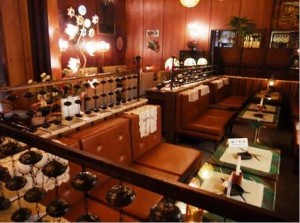JQ Magazine: NHK World, Your 24-Hour Guide to Japan

Pop singer and model Yun*chi and DJ Taku Takahashi of m-flo with Domo, NHK’s mascot, at Waku Waku +NYC in Brooklyn, Aug. 2015. The performers are frequent guests of NHK World’s J-MELO, Japan’s only music program recorded entirely in English. (Jason DeCrow/AP Images for NHK WORLD TV)
By Rashaad Jorden (Yamagata-ken, 2008-10) for JQ magazine. A former head of the JETAA Philadelphia Sub-Chapter, Rashaad is a graduate of Leeds Beckett University with a master’s degree in responsible tourism management. For more on his life abroad and enthusiasm for taiko drumming, visit his blog at www.gettingpounded.wordpress.com.
You surely watched NHK while you were living in Japan. Whether you understood the content was another story, of course. But with the right cable provider, you might be able to enjoy Japan in a way that you were unable to during your JET days, thanks to NHK World.
NHK World serves as the organization’s international broadcast service and features English-language programming devoted to Japanese news, sports, cuisine and culture. Even if your cable provider doesn’t have NHK World, the network streams all of its programming around the clock on its official website, and you can also download their apps to your smartphone or tablet.
What might you see on NHK World? Here are five programs that could tickle your fancy:
Hosted by Ayako Kisa, Sports Japan has profiled not only sports traditionally associated with Japan, such as sumo and kendo—and those not-so-traditionally associated with Japan, like beach soccer and unicycling. Episodes of Sports Japan broadcast highlights from a certain competition in the featured sport while Kisa interviews a journalist or prominent figure in that sport, such as Alexander Bennett (the coach of New Zealand’s national kendo team and editor-in-chief of Kendo World) in a recent episode devoted to kendo. The program is a fascinating look into what sports are practiced in Japan and who could emerge as the country’s next elite athletes.
JQ Magazine: JQ&A with James Rogers on Smart Smart Language Apps

“Some in government suggest that the path to citizenship includes learning English. What we intend to do is provide all of our apps to these learners, but entirely for free. It is a big dream of mine to give back to society in such a way.” (Courtesy of James Rogers)
By Rashaad Jorden (Yamagata-ken, 2008-10) for JQ magazine. A former head of the JETAA Philadelphia Sub-Chapter, Rashaad is a graduate of Leeds Beckett University with a master’s degree in responsible tourism management. For more on his life abroad and enthusiasm for taiko drumming, visit his blog at www.gettingpounded.wordpress.com.
For many of us, our time teaching Japanese people the finer aspects of English was limited to…well, the JET Program. But that hasn’t been the case for James Rogers (Aichi-ken, 2003-06).
As the president of Kyoto JALT and the founder and editor of the Kyoto JALT Review, Rogers has utilized his comprehensive knowledge of English-language education to develop Smart Smart, a series of apps containing materials geared towards Japanese learners of English and vice versa (as well as other language learners). Among their features, the apps contain more than 100,000 words of content, a textbook using modern music to study English, and pronunciation exercises for native Chinese, Korean and Japanese speakers.
To learn more about how Smart Smart has thrived and what’s ahead, JQ caught up with Rogers, who also happens to be a Ph.D. candidate doing corpus linguistics research.
How did your experience as a JET inspire you to launch Smart Smart?
The JET Program certainly was my first foot in the door in regards to English education in Japan—without it, I do not think any of this would have been possible. So, in that regard, I view my experience on JET as an essential aspect to my current successes with Smart Smart and my career teaching English at the university level. I think the JET Program is a wonderful opportunity for foreign teachers and Japanese students.
What inspired you to create Smart Smart?
Well, we really are still just in the beginning stages of really taking advantage of technology in education, and I just looked at what is currently available and realized that I could totally improve upon it drastically. Also, since I am a real teacher/researcher and do not depend on this to make a living, I could provide it for nearly ten times cheaper than some technology that is currently available. For example, over 30 volunteer researchers and translators helped me to create the content for over five years. Just the apps existing and the papers we’ve all published together helps all of our careers, so that is the benefit for the team. In addition, some team members already have tenure and Ph.D.s and just wanted to be part of something that truly had the potential to improve upon English education. Since I didn’t need to pay anyone to create the resources, the price we can sell them at can be kept at the bare minimum. Originally, I intended to actually release everything for free, but then I had the opportunity to collaborate with Ernie Thomason, the creator of the best-selling Flashcards Deluxe, and realized that not only can I provide the best quality content, but also the most cutting edge technology as well for mere pocket change. Without Ernie, none of this could have been possible.
Your apps contain well over 150,000 words of content. How often is the content updated?
We update the apps themselves—in fact, just last week we added a great new feature to the quiz function in the app. But the content, other than finding typos, is fixed. For example, the app 英語マスター1万/English Master 10,000 itself has over 100,000 words of example sentences. Each sentence highlights how to use one of the chunks it teaches (all chunks and sentences have translations as well). My Ph.D. research looked at years’ worth of corpus data from the Corpus of Contemporary American English to identify these chunks. So, basically, these are the high-frequency chunks of English according to the corpus. That’s a fact that doesn’t change, and thus no updating of content is really necessary. You know, chunks like “along those lines,” or “to make a statement,” or “a big deal”…these chunks aren’t going anywhere.
JQ Magazine: Manga Review — ‘Shigeru Mizuki’s Hitler’
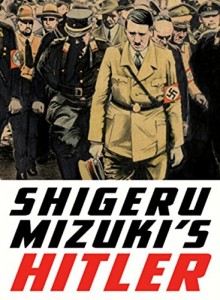
“Hitler is successful at educating us about the danger posed by people who can ride the waves of pain, fear, and anger in others to bring them crashing down onto the world.” (Drawn and Quarterly)
By Julio Perez Jr. (Kyoto-shi, 2011-13) for JQ magazine. A bibliophile, writer, translator, and graduate from Columbia University, Julio currently keeps the lights on by working at JTB USA while writing freelance in New York. Follow his enthusiasm for Japan, literature, and comic books on his blog and Twitter @brittlejules.
Welcome to the most difficult book review I have ever written. Not only am I challenged to write something meaningful about a great artist’s work on a very complicated and rightfully vilified man, but I also bear a burden on my heart as I address the passing of said great artist, Shigeru Mizuki.
Last week, the world lost a much-loved cartoonist. Mizuki brought comics into the world that celebrated the strange and mysterious with unique humor and style. He brought joy to generations, young and old, with his ever popular series GeGeGe no Kitaro. He also challenged us to face and remember atrocities of war in his own country, and others, by bringing to life the war he survived through his historical manga Showa: A History of Japan, an epic work available now in English in four volumes, and a manga examination of the life of Adolf Hitler, released in English just two weeks before his passing.
We have been able to enjoy more of Mizuki’s work in the West thanks to the publishing company Drawn and Quarterly and the herculean efforts of JET Alum (and JQ interviewee) Zack Davisson (Nara-ken, 2001-04; Osaka-shi, 2004-06), who translated all four parts of Showa as well as Hitler. Davisson, a great fan of Mizuki, maintains a blog on Japanese tales, monsters, and yokai, where you can find his own work and more about the legendary cartoonist.
JQ Magazine: Book Review — ‘The Inland Sea’
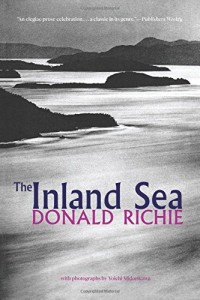
“Richie’s acerbic humor and wit are coupled with lush scenery and descriptions, offering an intoxicating and wry getaway.” (Stone Bridge Press)
By Alexis Agliano Sanborn (Shimane-ken, 2009-11) for JQ magazine. Alexis is a graduate of Harvard University’s Regional Studies-East Asia (RSEA) program, and currently works as a program coordinator at the U.S.-Asia Law Institute of NYU School of Law.
The Inland Sea by the late Donald Richie is a legendary book in the Japan field. For many, it’s their first foray into the culture. Following Richie as he sets sail across the Seto Naikai, the body of water which spans between the islands of Shikoku, Honshu and Kyushu, The Inland Sea chronicles Richie’s quest for authenticity and escape. There, among the hamlets and fishing villages which dot the coastline, he paints for the readers a sun-drenched and hazy seascape; encapsulating his journeys into a memoir, history, and travel book all at once.
Originally written in the early sixties, published in 1971 and subsequently reprinted over the years, the newest edition by Stone Bridge Press deserves a place of honor on your bookshelf—and in your mind. Richie’s acerbic humor and wit are coupled with lush scenery and descriptions, offering an intoxicating and wry getaway. The book is a solid combination of sardonic and sublime. Written as a series of essays, it’s easy to thumb through the pages, find a spot at random, and pick up at a new leg of the journey with Richie—just as he catches a boat with the tide.
This edition also features photographs by Yoichi Midorikawa, the Japanese photographer renowned for his black and white photographs which highlight the scenic, if not austere, beauty of Japan. These images complement the narrative, helping to conjure up a sense of lonely nostalgia. Despite the wonder of the world Richie paints for us, it is one where undercurrents follow mercurial moods as the author mulls on life, Japanese society, and the ever-worshiped god of “progress.” The first sentence to the book sets the tone: “Kobe, from where I have just come, is indication enough of Japan’s sad future.”
JQ Magazine: Manga Review — ‘Showa 1953-1989: A History of Japan’

“Shigeru Mizuki has led a full life of hardship and wonder. At the time of this book’s publication, he is 93 and still bringing laughter to many through his enormous body of award-winning work, which is thankfully becoming more available in English.” (Drawn and Quarterly)
By Julio Perez Jr. (Kyoto-shi, 2011-13) for JQ magazine. A bibliophile, writer, translator, and graduate from Columbia University, Julio currently keeps the lights on by working at JTB USA while writing freelance in New York. Follow his enthusiasm for Japan, literature, and comic books on his blog and Twitter @brittlejules.
Showa 1953-1989: A History of Japan is the fourth and final volume of the English translation of Shigeru Mizuki’s manga history of the Showa period. Translated for the first time into English by JET alum (and JQ interviewee) Zack Davisson (Nara-ken, 2001-04; Osaka-shi, 2004-06), the release of this book marks the end of a long journey for us readers. Mizuki took great pains to detail significant events of the Showa period and Japan’s role in World War II in order to preserve a comprehensive look at the time from the perspective of someone who had lived it. He intended this manga history to be a gift for all the generations born in a time of peace. As a reader born in the first year of the Heisei period, I was not even alive for any single event I read about, but nevertheless was moved by the power of Mizuki’s personal and historical storytelling and art to think about world history in new ways. The best part of reading something by Mizuki is you’re in for plenty of laughs along the way as well.
As a refresher for those of you who have been with us from the start, and an intro for those just tuning in, the first volume of this illustrated history of the Showa period in Japan covered the years 1926-1939 and highlighted a modernizing Japan and Mizuki as a child fascinated by spirits called yokai, and almost as importantly, a child obsessed with food. The book chronicled a number of incidents in Japan and Asia that took Japan down the road to World War II that come to a head in the second book which featured the years 1939-1944. This volume devotes itself to capturing the massive scale and harrowing death tolls of air-, sea-, and land-based conflicts in the war, and as time passes Mizuki’s own autobiographical narrative weaves in as he serves in the army. The third volume covers 1944-1953 and sees the darkest parts of Japanese history in World War II, and Mizuki’s own experiences are spotlighted, but it is not without the hope and admiration for humanity inspired from Mizuki’s encounter with the natives of Rabaul. This book also covers the Allied occupation of Japan and the beginning of what historians call “Postwar Japan” in which Mizuki starts down the path that will lead him to manga success and Japan becomes a booming economic power.
Interestingly, the last volume covers 1953-1989, which is 36 years of history and among the other volumes is the one that tackles the longest period of time. It’s also the most varied in its content. The same historical approach to events from a variety of perspectives narrated by either Nezumi Otoko or Mizuki himself persists through this volume, but as TV, movies, and popular culture take on an increasingly larger significance in society, so do strange events take on a more significant coloring in history. Mizuki devotes many pages to portraying abnormal events both comical and criminal that preoccupy the public mind by way of showing how times have changed since before the war. For this reason, the fourth volume at times can sometimes feel like a series of short historical episodes told in manga form, but of course presented in a chronological and unified way.
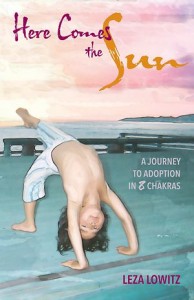
“Here Comes the Sun conveys how with persistence, perseverance and patience, seemingly impossible hurdles in Japan can be overcome.” (Stone Bridge Press)
By Rashaad Jorden (Yamagata-ken, 2008-10) for JQ magazine. A former head of the JETAA Philadelphia Sub-Chapter, Rashaad is a graduate of Leeds Beckett University with a master’s degree in responsible tourism management. For more on his life abroad and enthusiasm for taiko drumming, visit his blog at www.gettingpounded.wordpress.com.
“Sometimes, you have to travel a very great distance to find a home within yourself.”
That saying could certainly describe the journey of Leza Lowitz, a Californian who has worked extensively in Japan. She chronicles her path through several eventful periods—such as adolescence during the tumultuous early 1970s, her romance with a Japanese man named Shogo (whom she eventually weds), and her attempts to adopt in Japan in Here Comes the Sun: A Journey to Adoption in 8 Chakras, an autobiographical story that captures the ups and downs of Lowitz’s efforts to carve a niche in Japanese society.
As indicated by the subtitle of the book, Lowitz utilizes the influence of another culture to best integrate herself into Japanese society. But first, you might be asking… what’s a chakra? Derived from the Sanskrit root car (“to move”), a chakra represents a major wheel of energy in the human body, and each chakra contains a particular function. Chakras regulate, distribute and balance the energy and nerve functions of their locations.
Lowitz calls the chapters in Here Comes the Sun “chakras” and each one contains a certain theme. For example, the first chapter in the book is titled Muladhara, derived from the Sanskrit word for “root” or “support.” Some chapters in Here Comes the Sun deal directly with the yoga practices that balance a chakra—Lowitz tells us when the aforementioned primary chakra is balanced, you’ll feel stable and secure while being in a better position to succeed.
JQ Magazine: Book Review — ‘Kendo: Culture of the Sword’
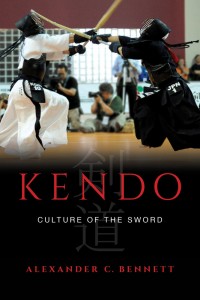
“Truly grasping Kendo might feel like learning Japanese—it’s a never-ending journey that feels overwhelming. But with persistence, the content will become easier to understand and quite enjoyable.” (University of California Press)
By Rashaad Jorden (Yamagata-ken, 2008-10) for JQ magazine. A former head of the JETAA Philadelphia Sub-Chapter, Rashaad is a graduate of Leeds Beckett University with a master’s degree in responsible tourism management. For more on his life abroad and enthusiasm for taiko drumming, visit his blog at www.gettingpounded.wordpress.com.
At pep rallies for my school’s sports clubs during my time on JET, I occasionally saw students decked in armor and masks while gripping swords. They were obviously members of the kendo club, but I had no idea what they actually did (other than participate in a martial art I knew nothing about). I was excited to start reading Kendo: Culture of the Sword so I could be properly introduced to the sport.
Written by Alexander C. Bennett, a New Zealander who has served as a professor at Kansai University and the coach of his country’s national kendo team, the book illustrates how kendo has evolved throughout the years from, among other things, a form of military training to a sport in which world championships are conducted every three years. More importantly, Kendo would teach me what happens in the sport.
Indeed, my initial expectations for the book were satisfied early when Bennett explained the “complex” rules and methods of kendo (even before mentioning the rules, he does us a gigantic favor by presenting the various names for Japanese swordmanship throughout the years—kenjutsu was actually the term long used to refer to the martial art). He also shines when he includes images of the sport’s equipment as well as a table detailing how you score a point. Bennett also provides fascinating information about the state of women in kendo: although there are references to women doing kendo that date back to early modern Japan, women only largely started practicing the sport after World War II (girls were traditionally taught naginata or kyūdō instead of kendo). In addition, even though women compete nationally and internationally in championship competitions, very few women hold positions of power in kendo education at a regional or national level.
JQ Magazine: Book Review — ‘Yurei: The Japanese Ghost’
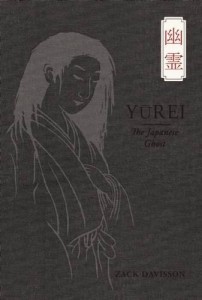
“If you like reading about mythology and supernatural horror around the world, or if you enjoy Japan’s unique brand of horror from such films as The Ring and The Grudge, then Yurei: The Japanese Ghost is a must-read.” (Chin Music Press)
By Julio Perez Jr. (Kyoto-shi, 2011-13) for JQ magazine. A bibliophile, writer, translator, and graduate from Columbia University, Julio is currently working at JTB’s New Jersey office while seeking opportunities with publications in New York. Follow his enthusiasm for Japan, literature, and board gaming on his blog and Twitter @brittlejules.
Do not read this review.
If you are foolish enough to read this review to the end…after seven days, you will be followed by a lingering spirit which will slowly, but unrelentingly, press more and more of its weight upon your shoulders. The weight will build to an unbearable breaking point, leaving you weak and overwhelmed by the scent of rotting flesh, driving your mind to unknowable depths of madness and despair. You can avoid this terrible fate by sharing this book review via the social media outlet of your choice or by purchasing Yurei: the Japanese Ghost, a new and excellent nonfiction effort by JET alum Zack Davisson (Nara-ken, 2001-04; Osaka-shi, 2004-06).
No doubt you’ve seen or heard of such films as The Ring and The Grudge, which have served as ambassadors of Japan’s very rich ghost culture (not to mention Halloween staples), but it is likely that there are aspects of these Japanese movies that you may have not been able to appreciate on some level. This book’s purpose is to fill in those gaps and fascinate you with an expertly catalogued evolution of ghost stories in Japan, and how pervasive they remain in pop culture to this day.
What exactly is a yūrei and why is it different from a Western ghost? What’s with the white face and long black hair? Why water? What drives the yūrei to do what it does? These questions and more are answered in this book. In the author’s words, “The goal of this book: to provide this understanding, to allow a clearer insight not only into the popular products of Japan but also the history and culture from which they sprang.” Yurei: The Japanese Ghost is a guided tour of the yūrei, from their appearance, to the rules they obey, to the traditions behind these characteristics. Davisson achieves this goal through the use of highly enjoyable primary choices and sharing the fruits of much academic research.
JQ Magazine: Book Review — ‘Mashi’
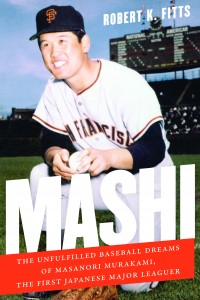
“JETs reading Mashi will relate to the story because just as many of us had support systems of friendly faces outside of the workplace, Murakami was fortunate that members of the Japanese American community in both Fresno and San Francisco provided a helping hand when he needed it.” (University of Nebraska Press)
By Rashaad Jorden (Yamagata-ken, 2008-10) for JQ magazine. A former head of the JETAA Philadelphia Sub-Chapter, Rashaad is a graduate of Leeds Beckett University with a master’s degree in responsible tourism management. For more on his life abroad and enthusiasm for taiko drumming, visit his blog at www.gettingpounded.wordpress.com.
During your JET experience, you probably heard about Japanese baseball icons such as Ichiro, Daisuke Matsuzaka, Hideki Matsui and Yu Darvish excelling in Major League Baseball. However, well before all of them were instilling pride in their countrymen through their feats on American diamonds, one southpaw from rural Yamanashi Prefecture was setting the big leagues on fire.
Baseball historian Robert K. Fitts introduces fans of the sport to Masanori Murakami in Mashi: The Unfulfilled Baseball Dreams of Masanori Murakami, the First Japanese Major Leaguer. The biography documents how Murakami went from a run-of-the mill relief pitcher for the Nankai Hawks to a major contributor to the San Francisco Giants in the mid-1960s that nearly punched a ticket to the World Series—all while being the subject of a fierce tug-of-war between the two organizations.
Piercing together information he obtained from interviews with Murakami, the pitcher’s close friends and experts on Japanese baseball, Kitts explores Murakami’s improbable journey to baseball stardom. Murakami was actually uninterested in baseball as a child and when he did develop a deep love for the sport, his father Kiyoshi objected to his son’s new passion. But Kiyoshi relented when he realized his son could earn a scholarship to an elite Tokyo-area high school.
Despite being a high school starter, a pro career was really not on the cards for Murakami, as his main focus was on attending college (and possibly pitching at that level). However, his success at Hosei II High School made him an attractive pro prospect and representatives from several NPB (Nippon Professional Baseball) teams offered him contracts. One of those teams was the Nankai Hawks, and they offered him something more than solely the opportunity to make a lot of money: the possibility of going to the United States to improve his craft, an idea that intrigued him.
JQ Magazine: Book Review — ‘Marathon Japan’
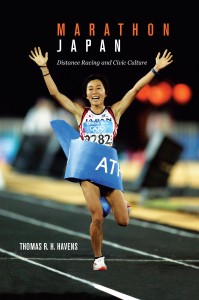
“The running boom in Japan shows no signs of slowing. Marathon Japan explains why as it marvelously highlights a growing and evolving sport.” (University of Hawai’i Press)
By Rashaad Jorden (Yamagata-ken, 2008-10) for JQ magazine. A former head of the JETAA Philadelphia Sub-Chapter, Rashaad graduated from Leeds Beckett University with a Master’s degree in Responsible Tourism Management (for more on his life in the U.K., visit his blog at www.gettingpounded.wordpress.com). While in Japan, Rashaad completed the 2010 Tokyo Marathon, ran two half marathons in Yamagata Prefecture, was a part of an ekiden club, and finished fourth in the 2009 Ishidan Marathon (a race up the steps of Mount Haguro).
Hopefully, your JET experience included you busting out your running shoes and joining your prefecture (or village) in a road race. It did for me on several occasions. But if you never got around to working up a sweat over 10 kilometers (or maybe even 21), you might remember your school being enthralled by its annual ekiden, or frequently seeing races televised on Sunday mornings.
So why have such events become an integral part of Japanese sporting culture? Thomas R.H. Havens examines why in Marathon Japan, the first comprehensive English-language book about the history of marathons and ekiden in the country.
Long before Kenya emerged as the world’s elite marathon nation, Japan could make a serious claim to producing the world’s best at 42.195 km. Marathon Japan illustrates the periods when Japanese marathoners dished out most of the world’s fastest times—such as the 1930s (In 1934, nine of the world’s ten fastest times were run by Japanese), the 1960s (1965 alone saw the Japanese record fifteen of the world’s top twenty marathon times), and the 1980s (during which Toshihiko Seko won ten of the fifteen marathons he completed in). And to top it off on the women’s side, in 2004, three Japanese finished among the world’s top eight marathoners.
JQ Magazine: Book Review — ‘Monkey Business Volume 5’
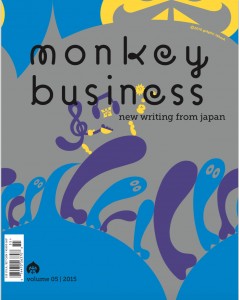
“Monkey Business is a magnetic force that attracts writers who can create magical kingdoms in a single page.” (A Public Space)
By Brett Rawson (Akita-ken, 2007-09) for JQ magazine. Brett is a writer, translator, and Ramen Runner. He has an MFA in Creative Writing Non-Fiction from The New School, and his writing has appeared in Narratively and Nowhere magazine. He is also co-founder of the quarterly publication The Seventh Wave and founder of Handwritten, a place in space for pen and paper.
After reading Monkey Business Volume 5, the image of a blender might pop into your mind. Perhaps this is because it is almost summer and you have recently begun making smoothies in the early morning. Or perhaps this is because you came across the description Monkey Business as genre-defying, which made you think of cross-genre, blending boundaries, and thereafter, the physical image of the object itself: the blender.
But most likely, this is because you read the opening vignette to Monkey Business, “Photographs Are Images,” by rising Japanese writer Aoko Matsuda, which ends as such:
Everything you’ve read up to this point has been images. […] These strings of letters are images. These chains of words are images. Stories are images. The story you’re reading this very minute is an image.
Carefully selected as the opener to Volume 5, this year’s Monkey Business is all about ways of seeing, and perceiving, images and the imagination, and objects and subjects.
JQ Magazine: JQ&A with Merry White on ‘Kissaten: Japanese Cafes Past and Present’
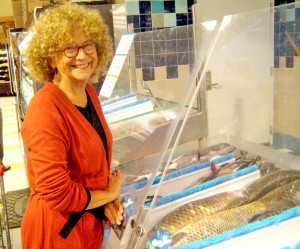
“Japanese coffee standards are the highest—when there is a new varietal on the market, it is often sent to Japan for testing. If a bean can make it in Japan, it can make it anywhere. The quality tasters are very keen, and there are fewer defective beans permitted than anywhere in the world.” (Courtesy of Merry White)
Brewing Up Something at Japan Society
By Alexis Agliano Sanborn (Shimane-ken, 2009-11) for JQ magazine. Alexis is a graduate of Harvard University’s Regional Studies-East Asia (RSEA) program, and currently works as an executive associate at Asia Society in New York City.
When it comes to notable food and drink of Japan, for many “coffee” is not the first thing that comes to mind. Yet, on May 21, Merry (Corky) White, Professor of Anthropology at Boston University, will teach audiences at Japan Society in New York City just how robust their coffee culture is, and how exacting their measurements are. Get ready for something good at Kissaten: Japanese Cafes, Past and Present.
White’s no newbie to food and Japan—it’s been much of the foundation of her professional work. If you look her up on Amazon, you’ll see that she’s been publishing food-related books since the mid-1970s, and regularly offers contributions to publications the world over. Definitely a foodie—and someone who knows her stuff. When not researching coffee and cafes, she’s active teaching about Japanese society, women in Asia, food and culture, and the anthropology of travel and tourism. Check her out on Twitter, where she regularly posts food- and culture-related content.
To whet your appetite for this program, JQ recently caught up with White to learn more about the coffee world in Japan, and what we can expect to hear from this rich presentation.
At your lecture at Japan Society, what do you hope to teach the audience about Japanese coffee culture?
I hope to surprise at least a few people, who may not yet know that Japanese coffee is a well-rooted, well-developed cultural product with a deep history. The coffee experience is also about cafes, koohii hausu, and kissaten, places with a special meaning that have developed over time in Japan. These places have offered people various distinctive experiences, depending on the era. The first ones, in the Meiji period (1868-1912), gave people a window on Europe, decor, clothing, foods—which continued into the Taisho period (1912-1926) when the flappers and lounge lizards demonstrated a new modernity, and the urban cultures were changing to, for example, give women a place in public, too. It was fine for a young woman of good family in the daytime, anyway, to go to a cafe, though probably she might have a chaperone…
Can you describe an iconic Japanese-style kissaten?
Kissaten are now places of memory, as well as ordinary community life. Brown kissa are the “sepia-toned” places where especially middle-aged people (I would say over 60s) like to go for a nice place to sit and get good service and maybe see friends. Young people like them, too, as they often share a love of the past (one they wouldn’t have had themselves) as a retro experience. Kissaten, though, also have more contemporary styles.
JQ Magazine: Book Review — ‘Gon, the Little Fox’
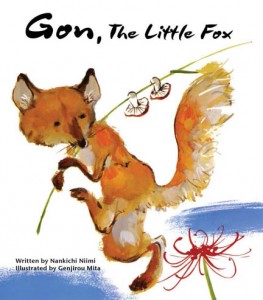
“Written by the legendary children’s book author Nankichi Niimi when he was just seventeen years old, the story brings to life a little rascal who never passes up a chance to cause havoc.” (Museyon)
By Rashaad Jorden (Yamagata-ken, 2008-10) for JQ magazine. A former head of the JETAA Philadelphia Sub-Chapter, Rashaad is a graduate of Leeds Beckett University with a master’s degree in responsible tourism management. For more on his life abroad and enthusiasm for taiko drumming, visit his blog at www.gettingpounded.wordpress.com.
You probably remember reading some of Aesop’s Fables—such as “The Tortoise and the Hare” and “The Boy Who Cried Wolf”—during your childhood. Or more importantly, the lessons those fables are supposed to teach.
Likewise, your students in Japan likely read similar tales, and one of them might have been Gon, the Little Fox. Written by the legendary children’s book author Nankichi Niimi (1913-1943) when he was just seventeen years old, the story brings to life a little rascal who never passes up a chance to cause havoc, like setting fire to rapeseed husks held out in the sun, to dry to stealing a farmer’s cayenne peppers.
However, Gon realizes he’s gone too far when he kills an eel intended to be eaten by the ailing mother of a villager named Hyoju. To atone for his egregious misdeed, Gon repeatedly gathers, among other objects, mushrooms and chestnuts to leave at Hyoju’s house. But Gon’s attempts at forgiveness are never acknowledged and the story ends tragically. (Premature deaths were an unfortunate aspect of Niimi’s life; his mother passed away when he was four and he himself died when he was twenty-nine.)

“By dramatizing some of the people who were on the receiving end of that racial hatred, I think the book might give a concrete sense of what American power can do when it is unleashed against people in other parts of the world. I hope the experiences of Jiro and Mitsuko make readers think twice about that.” (Louis Templado)
By Julio Perez Jr. (Kyoto-shi, 2011-13) for JQ magazine. A bibliophile, writer, translator, and graduate from Columbia University, Julio has had experience working at Ishikawa Prefecture’s New York office while seeking opportunities with publications in New York. Follow his enthusiasm for Japan, literature, and comic books on his blog and Twitter @brittlejules.
A Professor Emeritus of Harvard University, Jay Rubin has also served as a distinguished translator of Japanese literature for more than a quarter century, most notably on the works of Haruki Murakami. June 2 marks the release of his debut novel The Sun Gods (Chin Music Press), which is set in Seattle during World War II and explores the relationships between a Seattle-based Japanese national named Mitsuko and her young adopted American toddler, Billy, who are both interned by the U.S. government at the beginning of the war. Years later, Billy begins a journey to newly reconstructed Japan to find his Japanese mother and learn the truth about their shared past.
As part of the book’s launch, Rubin will be making live appearances from coast to coast, starting with Japan Society in New York on May 7 for an event titled The Magical Art of Translation: From Haruki Murakami to Japan’s Latest Storytellers, featuring other guest authors and moderated by JET alum Roland Kelts (Osaka-shi, 1998-99).
In this exclusive interview, Rubin shares with JQ the legacy of the war on his own writing, the attention to historical detail that went into The Sun Gods (with a few liberties taken), and what makes translating Japanese such a liberating experience.
JQ magazine readers are primarily JETs, JET alumni, and others who have worked and resided in Japan or have a strong interest in the country. Could you tell us about what inspired you to study Japanese language and culture and about any time you spent living in Japan?
In my second year at the University of Chicago, I was going to take one course on something non-Western for the fun of it, and one of the courses that happened to be available was an introduction to Japanese literature (in English translation, of course). I was so fascinated by the literature and by the professor’s remarks on the original language that I immediately started studying that language. I sometimes wonder what would have happened if the course I stumbled into happened to be Chinese history. I spent four years studying the language in Chicago before going to the country itself on a Fulbright fellowship. My spoken Japanese was so bad, all I could say to the young woman bartender at the first bar I wandered into was, “Do you realize you just used the word ‘wake‘ (わけ) three times?” I studied in Tokyo for two years, often wish I had made it four. I’m still remarking on how many times people use wake in sentences. I studied mostly Meiji literature while I was in Tokyo, not Noh drama like The Sun Gods’ Bill, though Noh was a side interest, and I did a lot more work on it in later years.
To start off talking about The Sun Gods, how would you describe your new book to potential readers?
This may sound like ad copy, but I’m comfortable with the summary on the book’s front flap:
Opening in the stress-filled years before World War II, The Sun Gods brings together a white minister to a Seattle Japanese Christian church, his motherless young son, and a beautiful new arrival from Japan with a troubled past. The bombing of Pearl Harbor intrudes upon whatever happiness they might have had together, and the combination of race prejudice and war hysteria carry the action from Seattle to the Minidoka Internment Camp in Idaho. Nearly two decades later, the son is ready to graduate from college when memories of Minidoka and of his erstwhile Japanese mother begin to haunt him, and he embarks on a journey that will lead him from Seattle’s International District to war-ravaged Japan in his attempt to discover the truth about his past.
The internment of people of Japanese ancestry in America that occurred during World War II is rarely dwelled on as much as other events of the war, how would you explain the internment and the reasons it warrants further attention to someone unfamiliar with the topic? What is the most important message you hope to get across?
If there’s a “message,” it’s to convey a historical moment, central to which was the fact that our government established concentration camps within its borders in order to lock up members of a particular racial group, and that this was supported by both public opinion and the Supreme Court with no constitutional justification whatsoever. The government has since apologized openly and eloquently, thus making a repeat performance highly unlikely. Japanese-American organizations, it should be noted, were among the most outspoken against anti-Muslim racism following 9/11.
JQ Magazine: JQ&A with Chin Music Press Owner Bruce Rutledge
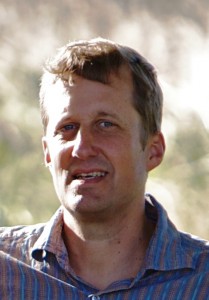
“JETs have a special bond, somewhat like people who go to the same university, and I think returning JETs can exploit that connection to open a few doors. JETs and MEFs are in all sorts of powerful positions these days at multinationals, news agencies, nonprofits, and government jobs. Use that network!” (Courtesy of Bruce Rutledge)
By Julio Perez Jr. (Kyoto-shi, 2011-13) for JQ magazine. A bibliophile, writer, translator, and graduate from Columbia University, Julio is currently working at Ishikawa Prefecture’s New York office while seeking opportunities with publications in New York. Follow his enthusiasm for Japan, literature, and comic books on his blog and Twitter @brittlejules.
After spending a few years in Chiba doing teaching and promotional work that would be all too familiar to JET ALTs and CIRs, Bruce Rutledge went on to work as an editor and writer in Japan for over 15 years. Today, he is the owner of Chin Music Press, a publishing company in Seattle with strong ties to Japan.
In this exclusive interview, Rutledge discusses his time as a Monbusho English Fellow (MEF), which was in some ways a precursor to the JET Program, and shares some of his experiences in a variety of media positions in Japan along with the origin and direction of Chin Music Press.
Since most of our readers are JET alumni, they’re probably already wondering about your connection to JET. Would you mind telling us a bit about the Monbusho English Fellowship you participated in? Why were you drawn to that program? Where in Japan were you placed, and how would you describe your activities as a Monbusho English Fellow? Also, how would you connect MEF with JET and compare it to what JET eventually became?
I was an MEF from 1985 to 1987 in Funabashi, Chiba, I think my job was sort of a combination of a CIR and a teaching assistant. I spent every Monday in the city hall doing PR work for Funabashi, whose slogan was “We More Sports.” I talked to them about this thing called a verb and how their slogan needed one, but my intervention was too late. Tuesday through Friday, I would teach in the schools. I taught a whole year at one high school and spent the rest of the time rotating from middle school to middle school with an occasional elementary school visit thrown in. It was a memorable period of my life. I loved my time there.
Are there any special anecdotes you would like to share from your time in Japan?
Perhaps the time a neighborhood kid of five or six broke into my apartment by climbing through an open window. The little burglar left his shoes on the windowsill. It was just the sort of juxtaposition I love about Japan.
When you finished with MEF, what was your next job? At that time, what direction did you see your life taking, and how did the your path end up differing?
After MEF life, I moved about 15 stops down the Sobu Line to Suidobashi and took a job with Universal News Japan. I was an editor and had planned to have a career in journalism. That plan worked out for nearly 15 years, until the Internet changed everything and I started longing to work in a longer form.
You seem to have had many media-related positions, mostly involving Japan or Asia. How would you describe the kind of work you did post-MEF? During those times, were you living primarily in Japan or somewhere else? How did that impact your performance in those jobs?
I lived in Japan for 15+ years. I never lived in another Asian country. I was a Louis L’Amour of white-collar jobs, doing a little bit of everything. I even did a 15-minute shortwave radio newscast from the bowels of NHK headquarters that aired at 2 a.m. Japan time. We would sleep in bunk beds from 2:30 to 5:00, then do another broadcast at around 5:30. That was the weirdest job I had.

